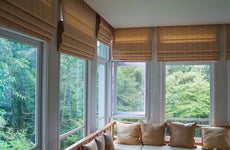What are smart blinds and window shades?

The Bankrate promise
At Bankrate we strive to help you make smarter financial decisions. While we adhere to strict , this post may contain references to products from our partners. Here's an explanation for .
Not that long ago, window treatments rose and fell with the yank of a pulley, a hands-on undertaking that felt like raising and lowering a canvas sail. But in the human race’s never-ending drive to do less work, blinds and shade makers began devising a lazy-person’s way to control daylight, how much to let in and when.
First, they created motorized shades and blinds you operated via a hand-held or wall-hung remote. Then they bumped up the functionality. They created window-clad self-starters that can be operated by a timer, a sensor (light, temperature, motion), an app or even your voice. Some even work with their own wakeup calls.
Welcome to the world of smart window treatments.
How do smart blinds and shades work?
Smart blinds and shades basically build on the technology of automated window treatments, which date back to the 1990s. They depend on a motor and various pieces of hardware, typically hidden behind a valence, or inside a fascia or a ceiling pocket. Designer/manufacturer/installer J Geiger Shading introduced “the first fascia-free motorized shading system without visible wires or screws” in 2012, says Marketing Manager Kendall Flock, adding that it is “still extremely popular.”
There are shades and blinds that plug into electrical outlets. Others can be hard-wired to a power panel. But the most popular motorizer is batteries.
Throwaway batteries typically last a year or more (up to two or three, in the case of Lutron’s, one of the leading smart-window brands), and then you must climb a ladder to replace them. Rechargeables may need juice after six months, and they will also require a ladder, as you need to plug in the charging cables — though you could leave the cords in place, hiding them behind curtains.
Smart shades and blinds also depend on a motor, electrically or battery-powered. For a fee, some smart ones can be coupled with a solar panel and solar-powered battery packs. The big difference is that, instead of using a separate remote, you control the action from afar via WiFi — something many homeowners already do with their security systems, HVAC systems and even appliances.
Here are the options for controlling smart shades and blinds:
- Via an app (either radio-frequency style, like Bluetooth, or WiFi-enabled, like a mobile app)
- With the help of a smart home system; a web-enabled hub; a bridge or gateway; or a virtual helpmate/speaker like Alexa or Google Assistant
Needless to say, if you are connecting your blinds or shades to a virtual assistant or smart home hub, such as those made by Apple, Samsung, Google or Nest, compatibility is key. Or you could opt for “an agnostic system,” Flock explains, which works with any home hub as long as you buy a “bridge,” a sandwich-size device that plugs into your router via an ethernet cable, and links devices and the internet, allowing you to control them remotely.
What can smart blinds and shades do?
Smart window treatments look like the conventional kind. Smart shades look like traditional roller shades (minus the cord) or they have a honeycomb, or cellular, construction for energy efficiency. Smart blinds are mainly horizontal or vertical slatted wood or another hard material.
Smart means you can open or close blinds and shades on a schedule or via voice or app commands (“Alexa, please plunge me in darkness.”) In some cases you can integrate the thermostat and sunlight, allowing a single command (“I’m awake”) to raise the blinds and turn up the heat.
Many smart window treatments come with their own branded bridges (which relieves you of the need to buy a third-party smart hub to access them). And it’s with the bridges that the real smart fun starts. Along with the aforementioned timer and thermostat features, you can program the blinds or shades to move automatically if the room’s temperature changes, if someone enters the room or if a door closes — via temperature, motion or contact sensors in your system.
Shades and blinds can both be coupled with light sensors, which raise or lower them in response to the light. In the case of some slatted blinds, a sensor can adjust the slats’ angle in response to too much or too little sun.
What are the advantages of smart blinds and shades?
For many homeowners, anything wireless is a plus. But the smart window treatments go beyond streamlined looks and internet-of-things games.
Let’s say you’ve got mobility or dexterity issues. Or you are concerned about cords, worrying about kids or dogs getting snarled up in them. Maybe you are often out of town and want your home to look occupied. Or you’re trying to save energy and your energy bills: By gearing your blinds to the amount of sun (and hence heat) pouring through a window at a given time, you can considerably affect the temperature of a room, alleviating the need to crank up the AC or the heating.
“We believe that your home should make you happy, bring you peace, give you energy and please your senses — morning, noon and night,” Vic Carlson, a marketing executive at Hunter Douglas, said in a prepared statement on May 3, 2022, referring to the company’s launch of the “next generation of PowerView Automation with Bluetooth technology” window treatments. “With these new innovations in form and function, we’re able to help consumers live beautifully at home.”
What are the drawbacks of smart blinds and shades?
Smart window treatments do come with some caveats.
- Limited looks: Smart shade and blind styles are increasing every day. Still, options are more limited, and so if you crave a special fabric or look, you might not be able to get it. (However, if you already have a simple mechanized system that you love, it might be able to be retrofitted with smart tech.)
- Extra expense: An architecturally correct cream-colored smart shade can cost up to $1,500, Flock says. Admittedly, she’s talking top-drawer, fully customized quality; more economic options do exist (Ikea sells a standard-size smart shade with a remote and app capability for $159, for example). But smart window treatments generally are double or triple the cost of their manual counterparts: A $400 blind can become a $1,200 blind once it acquires a brain, and it’s often more expensive to install, too. While brands like Lutron and SmarterHome both make shades designed for DIYers to set up, for the most part it’s wiser to go with a window treatment pro, given the systems’ complexities.
- Technological hassles: Depending on your current WiFi and the window-treatment system, you might have to buy a smart hub or bridge for the app to work well. A very large house may need a range extender, or repeater. You may want to spring for a backup hand-held remote in the event of a WiFi snafu.
- Motor problems: No one is saying the batteries and mechanisms that govern these smarties will last forever, so you will eventually have to replace the hardware. Also, some find the decibel level of the motors annoying.
Should you buy smart blinds or shades?
Smart window treatments are an investment, for sure. To see if they’re worth it, take a moment to study the way you interact with your current blinds or shades. If certain window treatments seem to take up too much of your time/strength, or you believe you can cut down on energy bills, it’s well worth considering a step into the smart blinds and shades world. You can always ask your smartphone or virtual assistant for the nearest dealer or store.
Related Articles


What are the different types of window treatments? A beginner’s guide

